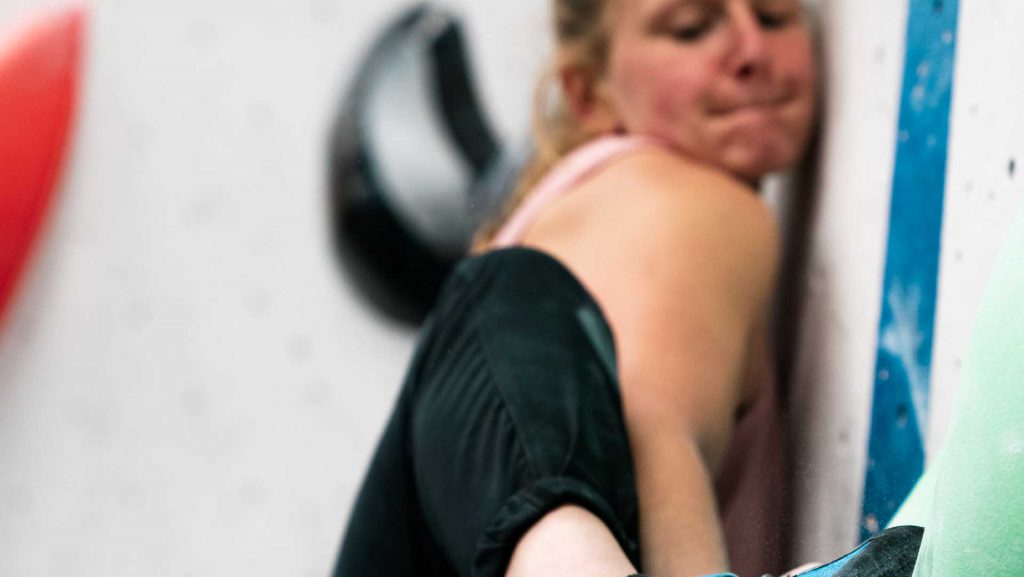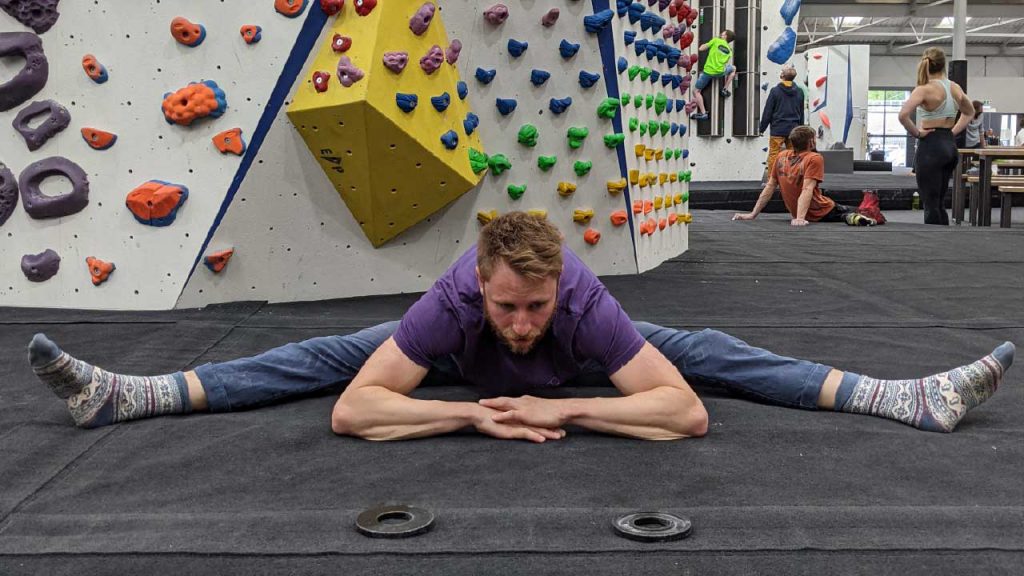The Fundamentals of Flexibility Training for Climbers
Every 2 weeks here at Lattice, the coaches get together and take it in turns to lead a discussion on a topic of their choice. We use these sessions to further educate ourselves and share ideas on the wide range of topics that play into climbing and training for climbing. Here we are looking to share some of the main takeaways so that you can apply them to your own climbing and training!
This week coach Josh talked about flexibility. The data we have collected has shown that flexibility plays an important role in climbing performance. Therefore we want to know more about how we can optimise training flexibility.
Types of flexibility
There tends to be some confusion around the terminology when it comes to flexibility. So the first step is to define flexibility.
Flexibility can be defined as the extent of range of motion that our limbs can achieve. However, people tend to be able to achieve different ranges of motion depending on whether they are using the muscles surrounding the joint to move the limb, or whether they are using assistance. This assistance might be another limb, or weights, or a friend to help them push into the split position.
You may have heard people explain this difference in terms of flexibility vs mobility. However, if we scan the sport performance literature for ‘mobility’ we come up short. There is no reference to ‘mobility’ when it comes to studies and explanations of range of motion (this space is reserved only for flexibility). Instead, everything that we find with regards to mobility is about the ability to move, or to be mobile. Although there is no need to get too pedantic about terminology, this is important for the purpose of understanding the literature and using this to form an evidence based approach to flexibility training.
So how do we distinguish between these two different ‘flexibility’ scenarios?
The way we like to differentiate between the two types of flexibility is active flexibility vs passive flexibility.
Passive flexibility is the range of motion that a joint can be pushed into. E.g. Think of that friend pushing you down into the splits!
Active flexibility is the range of motion that a joint can achieve using only the muscles surrounding and supporting that joint. E.g. think ballerina with their leg up high to their side and their arms gracefully making this look effortless.
One of the main reasons our muscles do not stretch into extreme positions, is that they are weaker when they are elongated or shortened. Conversely they are strong in the mid-range. Therefore the body protects itself from going into weaker ranges of motion where injury risk is higher. By increasing strength at the end ranges of motion we can teach the body that it is safe to go into those ranges. This is why strength training is an important component of flexibility training.

Common Myths About Flexibility Training
We should also dispel some myths that we commonly hear about flexibility training:
“Don’t stretch it’s bad for performance”
Some people stand by the opinion that stretching makes you slow or reduces your ability to be powerful. This was reported in a paper, where maximal power was shown to decrease immediately after long duration, passive, static stretching. It has since been shown that power quickly returns if the rest between stretches and power performance is increased. It is rare that anyone stretches before immediately jumping on to the wall to complete an all-out, power performance. Furthermore, in climbing we may not choose to extensively stretch the muscles with which we want to be most powerful prior to performance or training. For example, if we are talking about lower body flexibility, it is rare that we will use these muscles in a powerful manner. Therefore even if we did lose some power in our hip adductors from stretching them, this is unlikely to negatively affect climbing performance.
Flexibility and injury risk?
There are many papers out there that conclude that improving flexibility doesn’t reduce injury risk. However, the conclusion of any study is only as good as the method used. When we look at the methods used it may be that the most effective methodology for testing wasn’t used.
For example, a group of hockey players performed a sit and reach test. Their sporting season was then tracked for injuries. The conclusion being that the level of flexibility in the sit and reach test didn’t reduce injury risk. If we want to take this as a meaningful finding, then we need to be sure that the sit and reach test is an appropriate measure – is it specific to hockey and hockey injuries? It is likely that a sit and reach test is not the most meaningful measure in a sport where the majority of injuries will be from change of direction or dynamic injuries. When we consider this example, we see that the seemingly simple “being flexible doesn’t reduce injury risk”, is actually not that simple.
When looking to see if there is a relationship between flexibility and injury risk, we need to assess flexibility through sport specific movement patterns. For example, if a climber tweaks a shoulder this will often come as a result of having been in a more extreme position (imagine those high gastons). If you can increase your range of motion so that this position is no longer as extreme it may reduce the risk of injury in these moves. In particular if you can develop active flexibility in that range of motion. That is to say, that you have strength at the end ranges of motion.

Types of stretching:
There are 4 main types of stretching.
- Active Dynamic
- Active Static
- Passive Dynamic
- Passive Static
The ‘active’ forms of stretching are what we often hear people refer to as ‘mobility’.
These forms of stretching are quite simple to understand. The first words, ‘active’ or ‘passive’, refer to whether you are using the muscles surrounding the to complete the stretch or not. The second word refers to whether it is moving or not.
Dynamic flexibility and static flexibility can be trained separately. As with most trianing, improvement is most pronounced in the training method you use. Therefore, we can have individual variation between static-active and dynamic-active range. For example, we may be able to swing and kick our leg much higher than we can statically hold it. Or in climbing terms we may be able to kick our leg up onto a foothold but not place it there in a static controlled way, and thus may be sloppy with accuracy. We need to train both if our sport demands both.
Active Dynamic
An example of active dynamic stretching would be something like leg swings, which you might commonly use in a warm up.
Many climbers use this as a way to get going, to get their arousal level up – to feel ready to perform. They might have seen their friend do it, or it may simply be intuitive to them. However, there is a very good reason that we might want to use this form of stretching, and that is because of its effect on the muscle spindles.
Within the muscle spindles there are two fibers that act as sensors for the magnitude of stretch; one mainly picks up the velocity of the stretch and the other mainly picks up the force of the stretch. So, if we are not doing stretching with velocity then we are neglecting to train this component of the muscle.
Active Static
There are two main types of active static stretching (using our muscles to hold static positions near our end range). There is agonist isometric and antagonist isometric, and both are useful forms of stretching with their own benefits.
Agonist isometric
Agonist isometric stretching strengthens the muscle that we are aiming to stretch. By increasing the strength of those muscles at their end ranges of motion we make it safe to go into those ranges of motion, and therefore the muscles allow us to access that range uninhibited. One of the reasons our muscles do not stretch into extreme positions, is that they are weaker when they are elongated or shortened, and strong in the mid-range. In the image, Van Damme is strengthening his hamstrings and hip adductors at the end of their ranges of motion.
You may have heard of PNF (Proprioceptive neuromuscular facilitation) stretching? This would fall into the category of agonist isometric stretching, but uses assistance (often from a partner). PNF consists of intermittent contractions and relaxations. During the contraction the force exerted by the stretching person is countered by their partner. The relaxation window is used to push into a deeper stretch (again the assistant does the pushing). This works to get into a deeper range of motion is because there is a short window where you will get post contractive relaxation allowing for increased ROM.
Antagonist isometric
Antagonist isometric training is also a very useful exercise in developing flexibility, and involves contracting the antagonist muscle of the one we are aiming to stretch. It works via a mechanism called reciprocal inhibition. When you tense a muscle, it’s antagonist relaxes to allow the movement of a joint. For example when you bring your hand to your elbow, your bicep tenses, and your tricep relaxes to allow the elbow joint to move, otherwise the muscles would be fighting against each other. In the picture above, the athlete is performing a high V-sit, so their hip flexors are contracting and strengthening, causing their glutes to relax and stretch.
Passive Static
This is possibly the most well known form of stretching that there is. It is effective, but it is one of the methods that is likely to give the slowest results in flexibility. The methods above are essentially strength training. They are working on the principles of strength and conditioning, and working on physiological components. Whereas passive static stretching is essentially simply teaching the body to relax, and therefore it should be a much lower intensity stretch. This should be used more as a maintenance stretch where the intensity is much lower, while the higher intensity stretching should be done with the more active forms of stretching.
Passive Dynamic
Passive Dynamic is a form of stretching that is very rarely used, as it usually needs a partner to move the joints in and out of their end ranges of motion. The goal of this form of stretching is to teach the body to relax and the end ranges of motion as the golgi tendon organ receives signals telling it to create stiffness in the muscles as the body realises that it is safe to go into these ranges of motion it will relax and activate less frequently allowing for better range of movement.
Aims of each type of stretching
To summarise the aims of the different forms of stretching are as follows:
Active dynamic – increase range of active dynamic range including ‘cold flexibility’. Active dynamic flexibility depends on the “range in reserve” (the maximum warm range minus the cold range).
Active static – This is essentially strength training, the aim here is to increase strength in a range of movement. This is the fastest method when it comes to flexibility training. It increases the maximal static range and therefore the range in reserve.
Passive stretching (static and dynamic) – This helps to relax the muscles and is used to assist the other methods of flexibility training. This helps to increase warm range of motion, and also helps to speed up flexibility through increased frequency of flexibility training. Remember the strength sessions should be treated like any other strength training and require rest and recovery. Passive stretching is mainly neurological and so must be maintained regularly in order to feel the benefit.

How to incorporate flexibility training into your training plan
Active Dynamic – This style of training should be done daily and in every warm up. This element of flexibility training can be done very frequently without fear of overtraining or overloading. It should be done as sport specific as possible. What moves are you wanting to complete? For example, if you want to get high feet forward leg kicks (legs straight or bent) might be a good option.
Active Static – As mentioned before, this is essentially strength training and therefore will require around 72 hours for full recovery. This form of training can cause quite severe DOMS, especially when we are new to the exercise! This form of training can be completed as often as you would complete any other style of strength training (e.g. once or twice a week).
Passive Static – This form of flexibility work can also be completed daily or during warm up and cool down periods. It is useful to form a routine with passive stretching, such as on rest days or whilst watching your favorite TV programme.
Individual considerations – current flexibility
It is an obvious fact that our bodies are not all anatomically identical. This, along with the fact that we may be at different stages in our flexibility training, means that we may feel a stretch differently to our friends, even if we are completing the same stretch.
It is important to choose stretches, or variations of stretches, that are appropriate for our current flexibility status. Take the pancake stretch. If you were to do the gravity neutral variation (on the floor), but you weren’t able to get your lower back past 90 degrees, then you would benefit more from using the gravity assisted variation initially (stood up). Likewise, if you find gravity neutral position too comfortable, then moving to the gravity assisted variation would allow you to push the stimulus.
Individual considerations – bone structure
Another thing worth considering is our bone structure, and especially the position of our pelvis during lower body stretching. In flexibility training we look to change the structure of our tissues, but we can’t forget about the bone portion of the joint! Many climbers are interested in hip flexibility (and have plenty of footage of elite climbers using the full splits!), so let’s take the side splits as an example. The way in which we position our pelvis when we try to do the side splits will affect the range of motion that we can achieve. It is likely that if you test the limit of your hip flexibility in a few different hip positions you will get a different range of motion. If we keep a very neutral pelvis position you may feel a “compression” at the end of the ROM when your pelvis prevents further movement. To avoid this the key is to tilt your pelvis anteriorly, this means tilting your pelvis so that the front of your pelvis moves downwards (or in other words your bum sticks out). You can see Alex Megos using this position below to achieve a full split during a competition.
However, there is variation in shape when it comes to the pelvis and femur. This means that in some cases a person will have a structural limitation. Everyone’s bone structure is slightly different, and the head of the femur can be different from athlete to athlete. For the majority of people the head of the femur won’t limit flexibility, but for a small proportion of the population this will be the case. For these people there will be a genetic limit to the flexibility that can be achieved due to this genetic variation. This is due to either the size of the head of the femur, or the angle of the head of the femur. If you have this limitation then you will feel a hard finish at the end of your range of motion without feeling a stretch. This will be the point at which your bones meet. For most people pelvic tilt will allow the femur to go past the hip bone allowing for a deeper stretch, but in some cases this isn’t possible. Understanding this allows you to experiment and see if this applies to you.
Image of femur angles of inclination
Further reading:
If you’d like to learn more about flexibility three people that have done excellent work in the field are
Emmet Louis
Thomas Kurtz
And Lucas Aaron
If you look them up you will be able to learn a huge amount more about flexibility training.
A great book that we can recommend is Stretching Scientifically by Thomas Kurtz.
Read more of our Lattice Training Insights on the Lattice Training Blog






